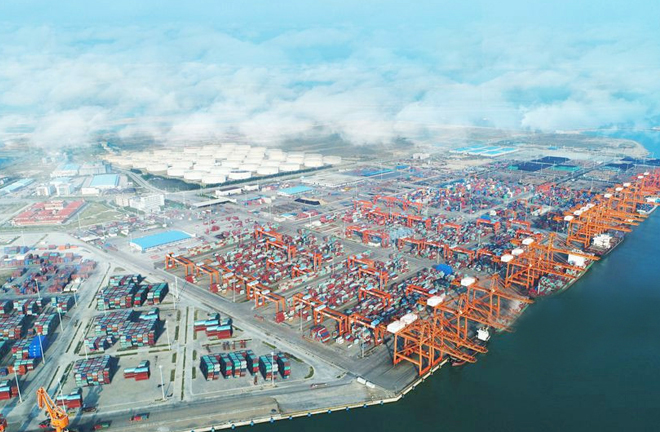With differentiated tasks, free trade zones generate investment opportunities

Qinzhou Port in Guangxi Zhuang Autonomous Region will become a pilot free trade zone. Photo: FILE
Yantai was among China’s first 14 coastal urban development zones in 1984. Now, the establishment of the Shandong Pilot Free Trade Zone (Yantai Area) marks another national-level haven for openness and innovation in the city.
The Shandong Free Trade Zone has put forward specific measures to cultivate new trade modes, accelerate the development of marine specialty industries and seek economic cooperation with Japan and South Korea. It will promote such sectors as high-end equipment manufacturing, new materials, a new generation of information technology, energy conservation and environmental protection, biomedicine, and production services. In the future, it has the potential to become a demonstration zone for national scientific and technological achievements and international technology transfer and application, said Zou Tianfeng, a staff member at the Shandong Free Trade Zone in Yantai.
Jiangsu Pilot Free Trade Zone will highlight the real economy by setting up a demonstration area for innovative development and industrial transformation.
“The approval of the Jiangsu Pilot Free Trade Zone (Lianyungang Area) is conducive to promoting Lianyungang to be a strong fulcrum in the construction of the Belt and Road (B&R) initiative within the province. It will help coordinate the development of the province’s eastern, central and western regions,” said Xiang Xuelong, secretary of the Lianyungang Municipal Party Committee.
Han Jian, executive vice president of the Comprehensive Institute of Pilot Free Trade Zones at Nanjing University, said that the Jiangsu Pilot Free Trade Zone has aimed at the transformation and upgrading of the real economy. This consists of the strategic tasks of the country’s major development and its reform and opening up and satisfies the needs for cultivating local advantages and self-development.
According to the overall plan, the Heilongjiang Free Trade Zone will undergo reforms in the next three to five years. It will become a high-standard, high-quality free trade park with an excellent business environment where people can embrace convenient trade and investment along with comprehensive services. It also aims to gather high-end industrial sectors and conduct efficient supervision.
The Heilongjiang Free Trade Zone is the northernmost free trade zone in China. In this regard, Da Zhigang, director of the Institute of Northeast Asia at the Heilongjiang Provincial Academy of Social Sciences, said that Heilongjiang will usher in a new regional layout. He believes that the Harbin area will become the supporting area and leading center of the free trade zone. The Heihe area, with an area of 20 square kilometers, will play a dominant role in boosting trade in China’s northernmost free trade zone. The Suifenhe area will engage in combined land and sea transport and the Harbin-Russia freight trains. This pattern displays the stable foundation of the Heilongjiang Pilot Free Trade Zone.
The Yunnan Pilot Free Trade Zone will strive to serve major access to South Asia and Southeast Asia in the construction of the B&R initiative and the Yangtze River Economic Belt, according to the overall plan. It’s good news to have explicit measures to form a center with extensive influence on South Asia and Southeast Asia.
Li Heliu, director of the Management Committee of National Kunming Economic and Technological Development Zone, said that the development zone will focus on the construction of the Kunming Area of the Yunnan Pilot Free Trade Zone in the future, and it will form a first-class business environment in line with international standards. The free trade zone will be equipped with convenient transportation and logistics, perfect financial services and a favorable ecological environment. A host of production elements can circulate freely there.
Cai Xin, a staff member of the Raw Jade Market Base in Ruili, said that the innovative cross-border economic cooperation model proposed by the overall plan empowers Ruili in the trade between China and Myanmar. It can consolidate the region’s position as a distribution center of raw jade and expand the local jade trade. Also, it can attract talent to Ruili.
“The construction of the Hebei Pilot Free Trade Zone is a major move to promote the coordinated development of Beijing, Tianjin and Hebei Province and build a new pattern of regional opening up,” said Zhang Jifang, director of the Foreign Investment Management Division of the Hebei Provincial Department of Commerce. It will push the development of a Bohai Free Trade Bay consisting of the Beijing-Tianjin-Hebei Metropolitan Region, the coastal area of Liaoning Province and the Shandong Peninsula.
The overall plan proposes that the Xiongan area will highlight the next generation of information technology, modern life sciences, biotechnology, and high-end modern service industries. Digital business and financial innovation will also be key factors.
China has included Guangxi Zhuang Autonomous Region, the only province in adjacent to the ASEAN counties by land and sea, into the distribution of free trade pilot zones. The decision recognizes the importance of Guangxi’s development and openness.
The free trade zone will be located in Qinzhou Port in Beibu Gulf. Therefore, the ports in the gulf will gather development momentum. “We must grasp the opportunities to build a new model in which railways and shipping are the mainstay of transportation while short distance connection and warehousing serve supporting roles,” said Huang Guanghui, director of Qinzhou Port at Guangxi Coastal Railway Economy and Trade Company.
This article was translated from Economic Daily.
edited by MA YUHONG
